|  |
Mont-by-month info
July and August 2014
To cellebrate the end of the LIFE-Lomme projet, a foot rally was held on the 2nd August 2014. This was a succes : 424 people attendend the rally ! They could discover the aims of the project and the actions accomplished during 5 years.
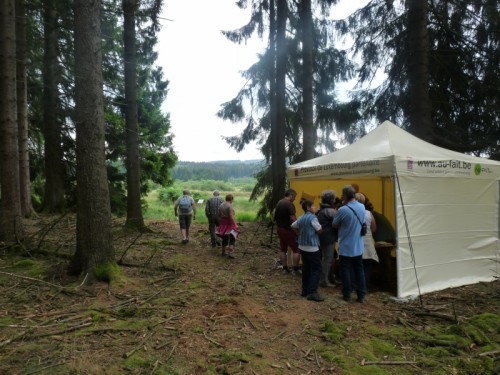
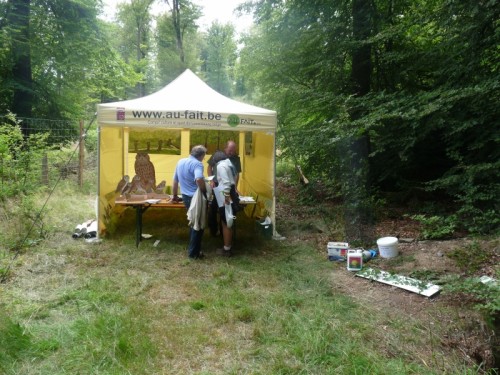
June 2014
Informative session are organized in June, about the restoration works relalized by the LIFE-Lomme project and about their first results :
- 17 june at 18h30 : visit of the wet meadows in the Val de Poix (Saint-Hubert) - meeting point at the "salle communale" in Saint-Hubert
- 17 june at 20h00 : information evening - meeting point at the "salle communale" of Saint-Hubert
- 19 june at 18h30 : visit of the "prés Chaulette" (Libin) - meeting point at the Church in Libin
- 19 june at 20h00 : information evening - meeting point at the "salle du Loup Garou" in Smuid
- 24 june at 18h30 : visit of the Mâ d'Eau bog (Tellin) - meeting point at the exit n°23a on the E411
- 24 june at 20h00 : information evening - meeting point at the "foyer culturel" in Bure
- 02 july at 18h30 : visit of the Anomalies bog (Libramont-Chevigny) - meeting point at the "salle communale" in Libramont
- 02 july at 20h00 : information evening - meeting point at the "salle communale" in Libramont
May 2014
During the month of May, several LIFE sites have been removed from all new spruce plants. Numerous working hours have been necessry to achieve this action.
April 2014
The 11th of April, we organized a meeting with hunters, environmentalists and forest managers. Discussion were related to the impact of LIFE-nature projets restoring peatland and heathland on hunting and game behaviour. A booklet on this topic will be published by the LIFE-Lomme.
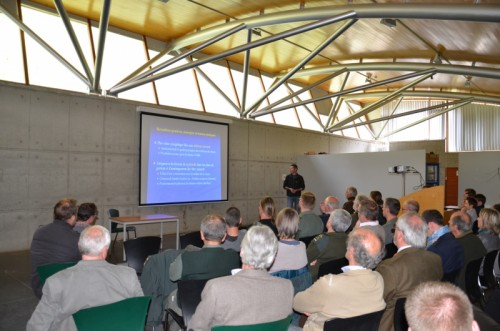

March 2014
Since the begenning of the LIFE-Lomme project, around 100 ponds have been created.
We studied the colonization by amphibians and observed already 6 species in the recent ponds : Common Newt, Palmate Newt, Alpine Newt, Common Frog, Edible Frog and Common Toad.
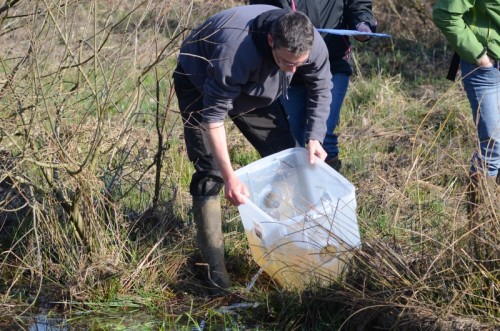
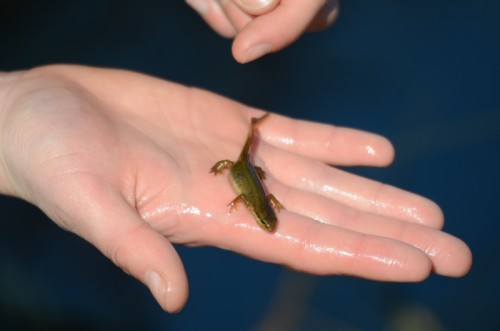
February 2014
Willow cuttings were planted around restored heathlands. Willows will have a role of schelter for small animals and will ensure tranquility for the fauna when placed betweden roads and restored sites.
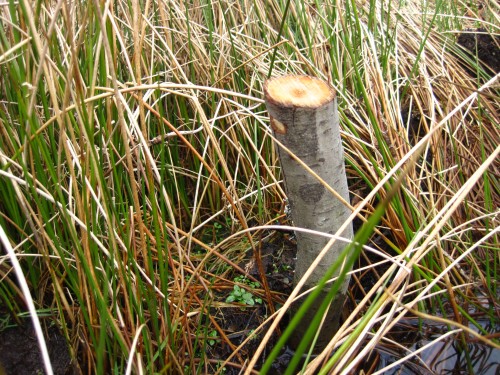
January 2014
Willow cuttings were planted around restored heathlands. Willows will have a role of schelter for small animals and will ensure tranquility for the fauna when placed betweden roads and restored sites.

December 2013
The whole team at the LIFE Lomme Project wishes you a Merry Christmas and a Happy New Year for 2014!
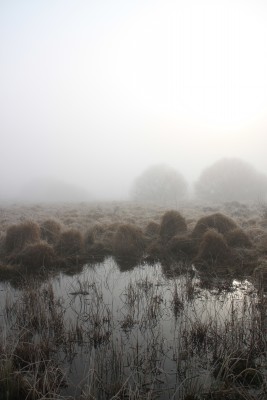
November 2013
Progress continues on the addition of paddock fences with the laying of 3 enclosures at the springs of Tellin Woods and 2 enclosures on the Wetland Zone of Biological Interest at the Troufferies de Libin. Together they cover a total area of 33 ha. This area will be used for extensive grazing for hardy breeds of cows (Highland or Galloway) starting in summer 2014, and this is all thanks to cooperation efforts from local farmers.
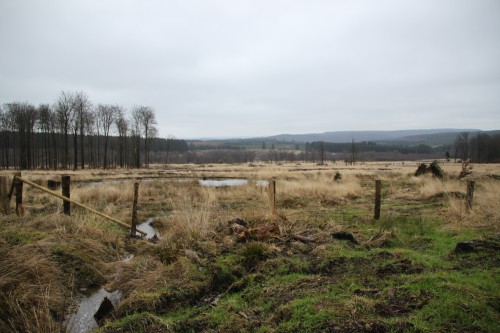
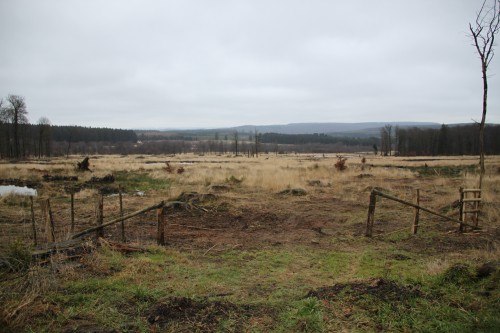
October 2013
The laying of exclosures with hardwood diversification, provided with the aim of protecting natural hardwood regeneration and protecting our future plantations from various elements, planned for this winter, is coming to an end. This consists of just under 9 km of ursus fencing which has been put up and which is currently protecting an area measuring +/- 23 ha.
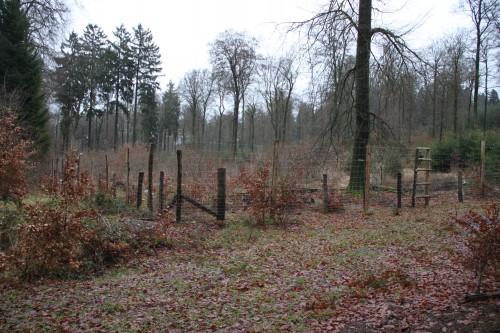
September 2013
Two spruce clearings underwent significant tillage - destruction of stumps and slash and soil levelling – so as to allow it to be managed by a tractor-mower. The seed bank was severely depleted and there were no mowed meadows in a good state of conservation in the immediate vicinity of the sites. To speed up the return of vegetation that is typical of the restored areas, seeds were harvested from neighbouring areas this summer and were sown mechanically.
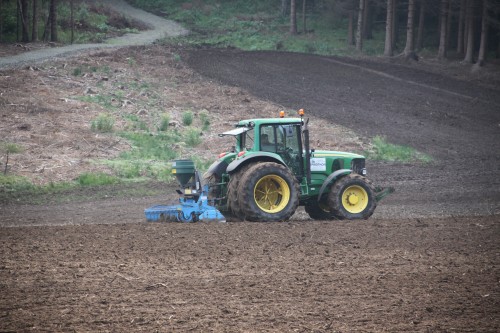
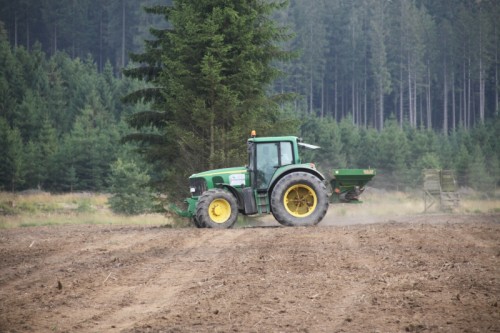
August 2013
The wet grasslands of Val de Poix had some minor lifting. These abandoned areas of pastureland have been largely colonised by megaphobia which demonstrates the high level of nutrient inputs that occur each time the brook that runs through them swells. In order to improve the conservation status of the meadows, mowing and hay removal are to be undertaken by a local. To ensure the feasibility of mowing on this land, a contractor carried out a conclusive test this summer with the help of a dual-wheeled tractor.
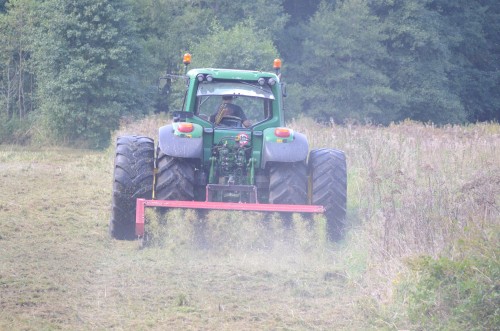
July 2013
In the free-range pens, we are planning to have a full complement of ponds to serve as drinking water for cattle . So that the trampling of hooves doesn't turn the bank around the pond into a field of mud, we are limiting the animals' access to a maximum of 25% of the watercourse perimeter. This demonstrates how the LIFE-Lomme Project has taken charge of protecting the ponds. If the farmer chosen to manage the site wishes to make even more progress they may also opt to protect the other small water courses on the site. It is generally advisable to leave the pond accessible for the cattle (i.e. the part of the pond that is not fenced off) on the southern side. Due to the trampling of the animals, the shrubs are not given a chance to grow on this part of the bank. This guarantees that the water course has access to a healthy amount of sunlight.
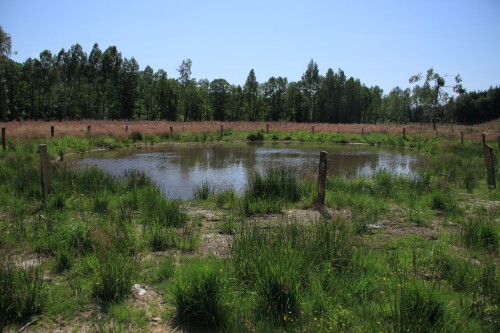
June 2013
The Libin Bridge is cloaked in a beautiful shade of green. Five young Galloway calves arrived at the site in mid-June and are spending their days peacefully there. Their grazing pen has been divided into three sections, according to the moisture gradient in the soil. By separating the drier areas from the wetter areas it stops any signs of overgrazing on the first areas and abandonment of the second. Generally, the grazing season begins on the dry part; the animals are then transferred to the wet area (which dries out as much as possible on nice days).
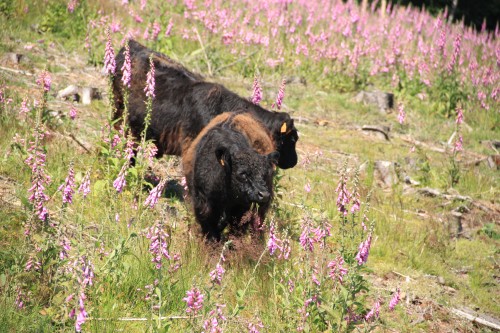
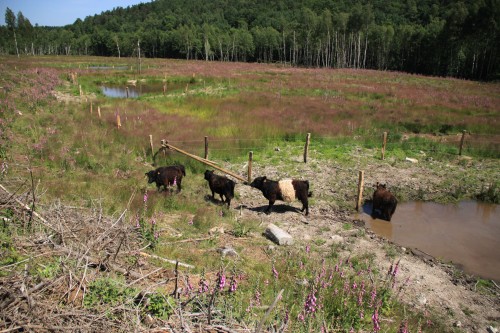
May 2013
Restoration work on the Noire Eau Valley continues. The waterlogged soils have been cleared of softwoods, in particular through the use of rotary slashing. The aim is to restore peaty moorland that forms a continuum with the nature reserves of the Troufferies de Libin. This continuum should encourage the species typically found in the habitat to return to the area quickly. A small section of the valley had been taken up with Sitka spruces. This species proves to be somewhat recalcitrant under the teeth of the grinder, leaving behind a landscape of candles on the way...
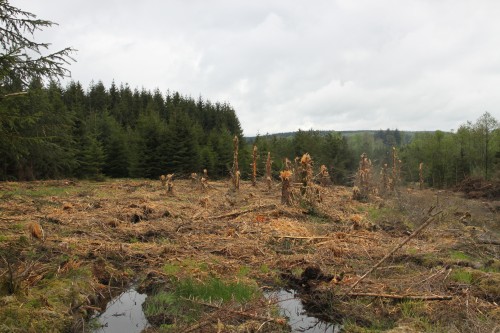
April 2013
The European adder is a rare and highly endangered species found in the region of Wallonia. A small population has been found within the perimeter of the LIFE-Lomme Project. To measure the size of this population and to avoid any individuals being destroyed during the restoration works, a network of sheets (sheet metal and roofing) has been placed in and around the relevant site. The adders appreciate the warm micro-climate that is to be found underneath these sheets and willingly confine themselves to them. Intensive surveying over the next few months will allow the individuals observed underneath the sheets to be moved to areas that will not be disturbed by machinery.
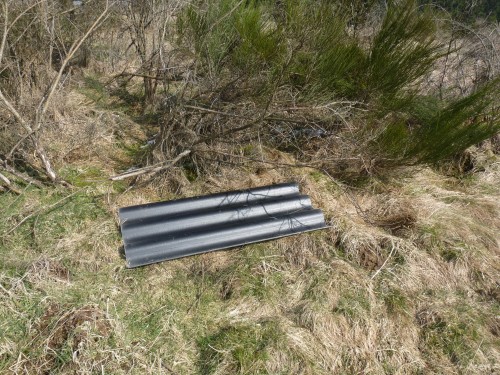
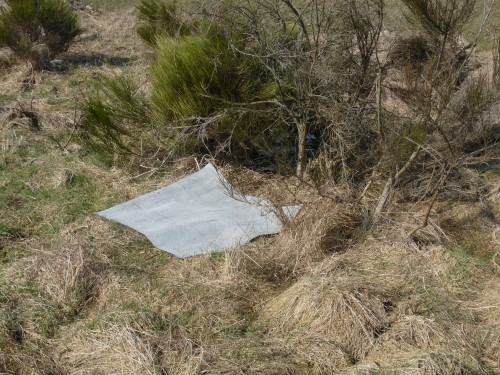
March 2013
An “abyssage” channel (traditional irrigation practice) has been reinstated at Libin Bridge (in the municipality of Libin), on its previous route. The canal overflows will allow the mire between the channel and the Lomme to be flooded.
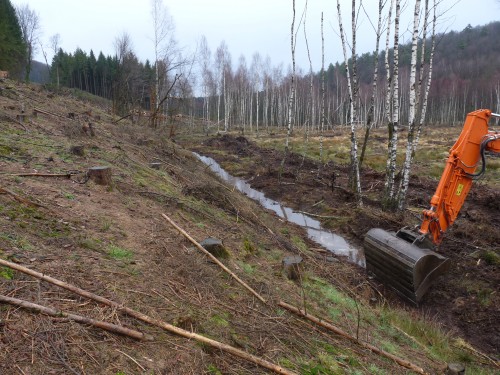
February 2013
Preparations are underway for the first grazing enclosure at the Fagne de Wiaupont (in the province of Mirwart). The enclosure covers approximately 5 hectares and as of 2013 will have rustic Highland cattle grazing upon it.
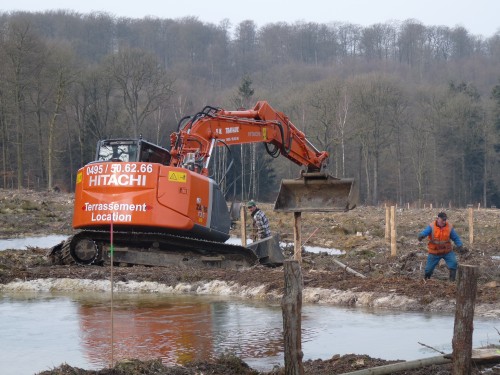
January 2013
The Fange de Tailsus (Municipality of Libin) has undergone some light lifting, via a small amount of top peat removal in an area that has been degraded by the Molinie. The areas where peat has been removed were very quickly flooded, thanks to the swaths that retained water.
.
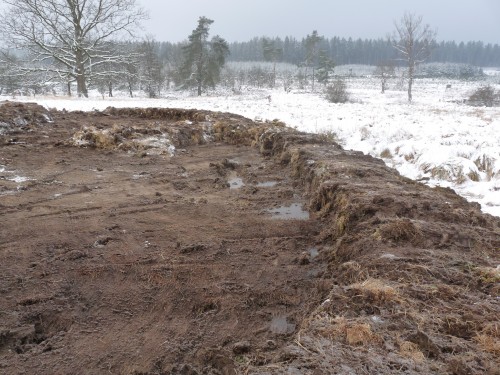
December 2012
The Fange des Anomalies is situated in the small valley of the Barrière stream, above the municipality of Libramont. There are still some superb peaty areas there despite some colonisation of the open areas by natural spruce plantations. Thanks to cooperation with the municipality, restoration of the valley is underway. Here, a caterpillar is seen reopening the area by rotary slashing young spruces.
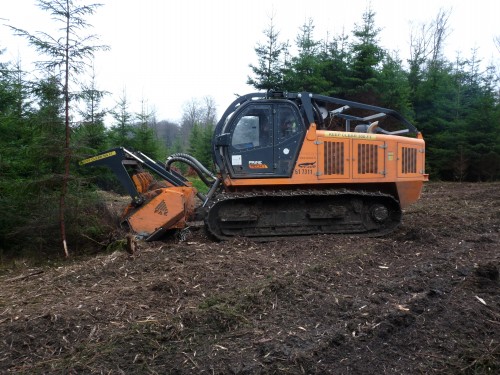
November 2012
Despite the absence of a catchment area, the top peat removal carried out this summer on the site at Contranhez (see "July-August 2012") is slowly beginning to become submerged thanks to the storm water. Winter is expected to allow the proportion of the area under water to increase.
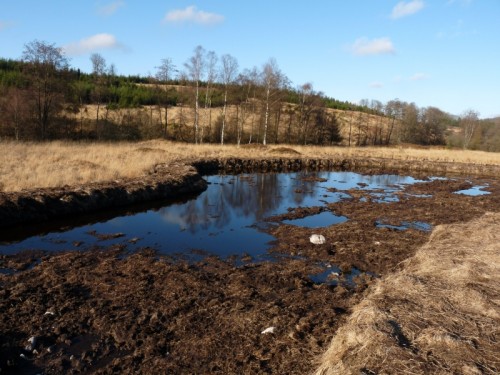
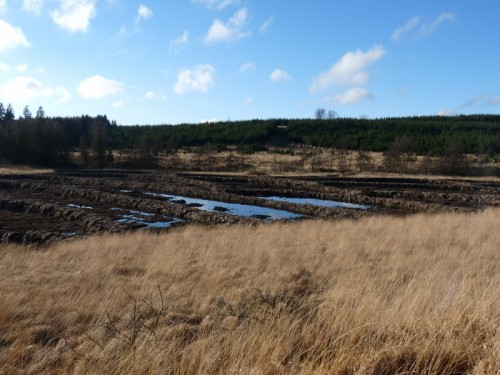
October 2012
The Fagne de Wiaupont was cleared of trees in 2011 (see "November 2011"). After having exported the remains from the clearing work, water-related works were carried out and have resulted in three types of water courses. Two water courses are large in surface area but limited in depth, thanks to the introduction of two mineral dykes. There are five pools of a limited surface area. 54 mardelles were created by clogging the drainage network.
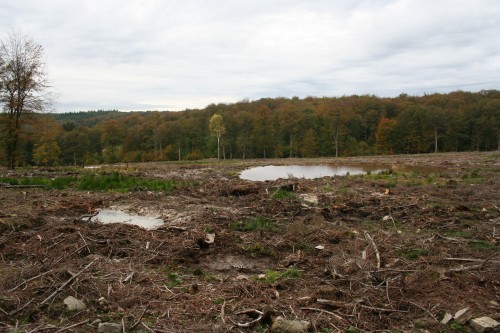
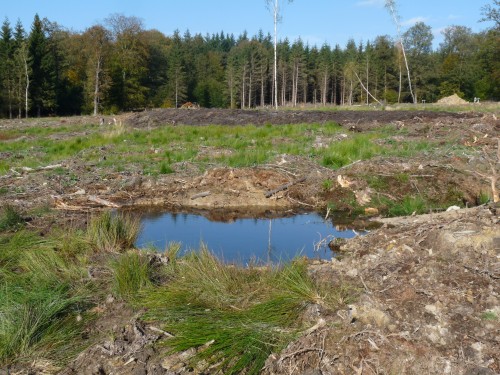
September 2012
Restoration of the poor grassland on the plateau at Recogne has been faced with a high density of wild boars. The restoration of an area of grassland (milling of the earth in particular) and the mowing of this grassland makes the land very attractive to wild boars . This reduces the soil to the search for bulbs and earthworms, etc. When the damage caused covers large swathes of land, the consequences can be damaging for the natural environment.
In areas with a very high density of wild boars, it becomes essential to protect the land with the help of a fence that prevents the wild boar from entering. This is what has been done along the border of the Troufferies de Libin Nature Reserve: a communal meadow in the process of being restored has been fenced off. The restoration consists of making it possible to mow the land by crushing the vegetation. Mowing and removal of the hay will allow the grassland to be maintained over the long term.
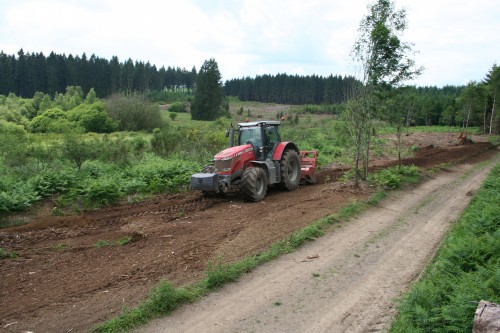
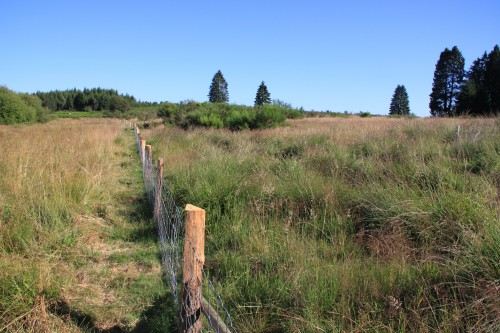
July and August 2012
The top peat removal works that began in spring at the Troufferies de Libin Nature Reserve are still underway.
The first image illustrates the (very) fast return of vegetation to an area that has recently had the top peat removed (see "April 2012"). This summer, this area has already attracted several species of interest from a heritage point of view, including the Blue Skimmer and the Green Sandpiper.
The second image depicts the place called Contranhez, an enclave of the reserve situated between the Noire Eau and the railway.
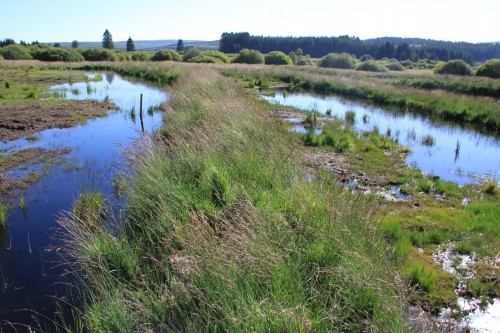
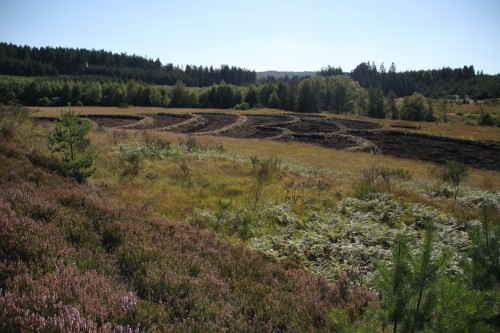
June 2012
Four ponds were created this spring at the Domaine Provincial de Mirwart , close to the fish farm. There was already a relatively large number of water courses in the surrounding area but the majority were very artificial (fish ponds). The ponds created by the LIFE-Lomme Project are characterised by being small in size, with a gentle slope and shallow depth. These characteristics are intended to make the ponds attractive to various species, including dragonflies. The Provincial Domain showcases the value of the ponds with a short nature trail.
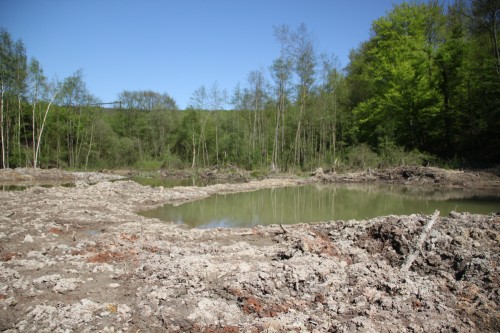
May 2012
The restoration works, and especially the crushing works of young spruces, are undertaken outside of the periods that are the most sensitive for the local flora and fauna. The specifications provided to contractors traditionally stipulate that works must come to a halt for a period between mid-April and the end of July so as not to disturb the nesting.
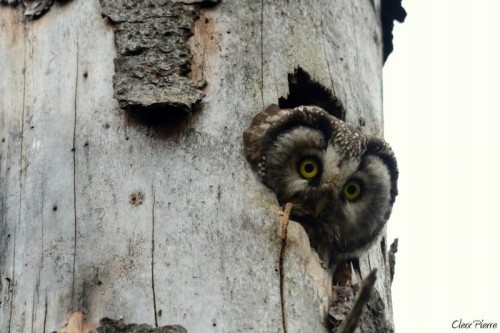
April 2012
Initial top peat removal works within the Troufferies de Libin Nature Reserve. Top peat removal consists of stripping away the surface layer of the soil, which is generally in moorland areas that have been degraded by the Molinie (grass). Top peat removal has two objectives :
(1) to destroy the root system of the Molinie. The Molinie is so expansive that it stops other species from being able to develop there.
(2) stimulate the 'seed bank'. These are seeds that have accumulated in the soil over the years. Whilst the seeds are still viable, exposing them to the light again allows them to germinate.
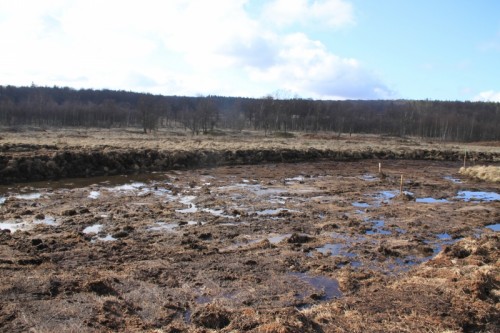
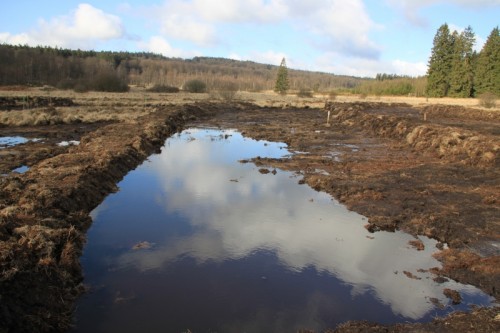
March 2012
On the ground at present the first softwood harvesting is underway, the drains can be easily identified. When the drains are still active, they can be located with the help of a GPS in order to specify the restoration that is to be undertaken. Depending on the slope of the land, for example, the way in which the drains are plugged can be adapted. A steep slope will require mineral clay plugs more frequently than a gentle slope. The first water restoration sites are currently being prepared and concern the Parfond Ri (in the municipality of Saint-Hubert), the Pont-de-Libin (in the municipality of Libin) and the Lomme Valley downstream of Bras (in the municipality of Libramont).
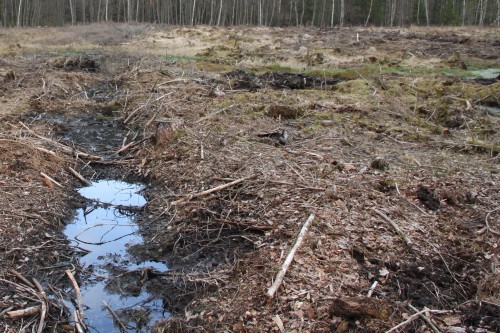
February 2012
Work continues in the municipality of Libin. It is here that the small valley of stream of the Pierre au Charme is benefiting from a clearing of softwood trees. The trees have been felled and are awaiting the arrival of a crusher. Once they have been crushed, they will be sent to the wood energy sector.
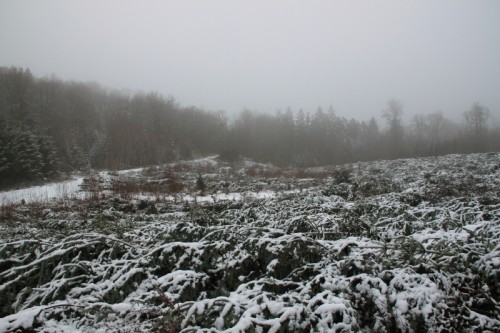
January 2012
The softwood stands that have been converted into natural habitats within the framework of the LIFE-Lomme project can be divided into three categories, according to their market value. They are classified as follows:
- wood with a diameter that is sufficient to be used in the traditional wood sector (slicing, pickets, crushing). This wood has a high market value.
- wood that can be used in the wood-energy sector (especially pellets). Generally speaking, this is wood aged between 15 and 23 years. The market value of this wood is middling to none.
- wood with no market value because it is too young or because its low density does not allow it to be used in the wood-energy sector. In the event of the latter, no benefits are gained from cutting the softwoods; on the contrary, a contract has to be signed with a paid contractor.
Currently, several softwood stands belonging to the second category (wood-energy) are used by two commercial loggers in the municipality of Libin.
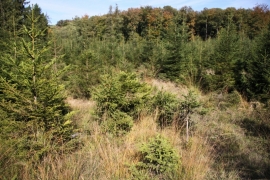
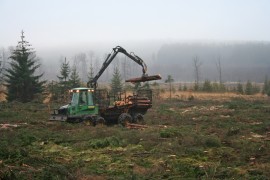
The picture on the left depicts natural regeneration of young spruces without any market value (Ri Le Glan – Municipality of Libin). The crushing of these trees requires contractors to be called in. On the right are young softwoods that are large enough to be processed and used as posts (Around the Nature Reserves of Troufferies de Libin – Municipality of Libin).
December 2011
Rotary slashing work was carried out in December at the Nature Reserve of the Troufferies de Libin and the surrounding areas. This work consists of eliminating the natural regeneration of spruces which are still too young to be sold on the timber market. The surface area in question is 28.75 hectares, of which 0.65 hectares have been preserved for game. Given the poor traction conditions of this moist soil, machinery was systematically equipped with broad tracks. The high density of softwoods in certain areas and therefore the substantial thickness of the pulp will probably require the material to be raked up in order to allow light to reach the soil.
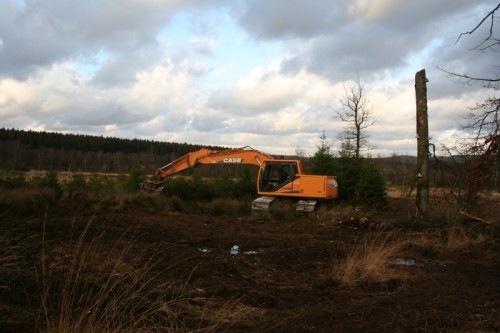
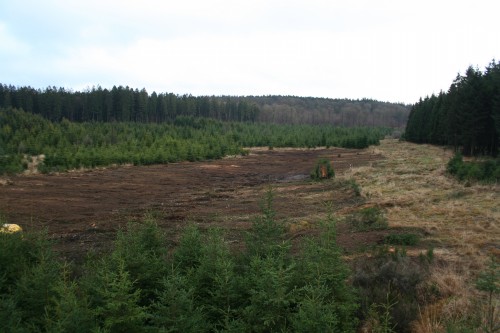
November 2011
The Fagne de Wiaupont is situated at the source of a small forest stream, the Parfond Ri (municipality of Saint-Hubert). The land making up the mire belongs to the Provincial Domain of Mirwart which decided to work together with the LIFE-Lomme Project to restore areas of natural wetlands. Three areas of the Fange that have been cleared of softwoods will be restored in open environments. The first area –approximately 6 hectares- has recently been cleared. The residues from the clearing were once again used in the wood-energy sector.
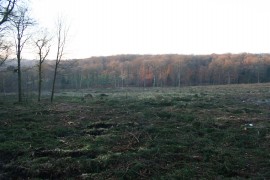
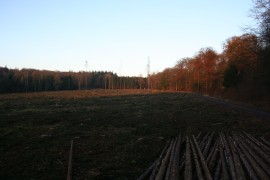
October 2011
Work is continuing at Pont-à-Libin. The clearing residues have been placed in piles (swaths) and have been exported in order to be used in the wood-energy sector. The site was particularly suitable for this purpose: easy access via forest paths, very favourable weather conditions (dry weather), residues that are still fresh, shorter distance to the wood-energy industry.
Making use of residues is an opportunity for restoration projects. In order to speed up the return of vegetation in the former softwood stands, cutting residues are often placed into piles. The wage of the contractor hired to carry out this work is covered by the LIFE project. But when it is possible to make use of the residues, the contractors reduce the amount on their invoice for the swathing work. We may therefore consider their wage to be partially paid by the LIFE project and partially by the company that buys the residues.
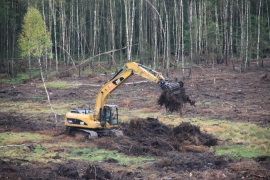
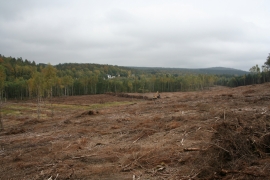
September 2011
The locality of Pont-à-Libin is situated in the municipalities of Libin and Saint-Hubert in the immediate vicinity of Hatrival station. This is the river basin of the Lomme. There are still beautiful flood plains in the area but the majority of the site has been cleared of softwood. The LIFE-Lomme Project was able to buy up 10 ha from one sole tenant, on which the spruces were cut down in summer 2011. What will become of this area? In the future it will enjoy the status of a Nature Reserve. Easy access and the large surface area also make this an ideal site for managing extensive pasture farming with rural cattle.

July-August 2011
Tests for mowing by horse-powered traction were carried out this summer at the Pré des Forges (NR). The main difficulties encountered by the contractor were the height and the density of the vegetation (meaning that the mower's cutter bar became blocked on a regular basis) but also the micro-relief of the soil (the bar bouncing over every small mound of earth). The advantage of horse-powered traction primarily lies in the lightness of the material, which is particularly suitable for wetter areas of land. There will have to be an investigation into the possibilities to improve upon these initial tests.
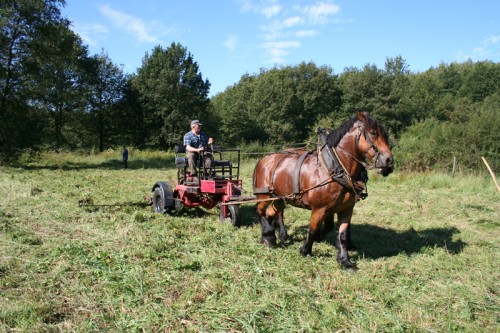
June 2011
The first restoration works are underway! The nature reserve at the Troufferies de Libin and part of the Fange de Tailsus have been cleared of their natural spruce regeneration. 75 ha have been meticulously covered by a woodcutter equipped with a trimmer and a chainsaw. The work was carried out in 13 days.
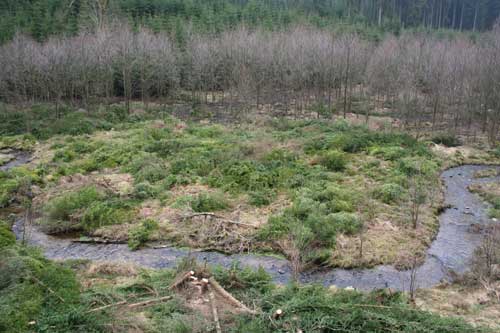
May 2011
Public survey concerning designation orders for Natura 2000 sites – In the Region of Wallonia, 240 Natura 2000 sites have been delimited which make a contribution to the European ecological network. To give these sites legal recognition, they must receive a “designation order”. The designation order specifies which natural habitats and which species of community interest are to be found within the confines of the site. It also specifies the management measures that must be respected in order to keep these natural habitats in a good ecological condition or maintain viable populations of species. Before being published in the Moniteur belge , the designation orders will be subject to a public enquiry. Any person who is affected (owner, manager, resident, naturalist, etc ) may submit an opinion on the draft designation orders. These may be consulted from 1 June until 15 July in the municipal administrative offices and in the offices of the Department of Nature and Forestry. The competent authority of the DNF on the perimeter of the work on LIFE-Lomme is the management of board Neufchâteau.
April 2011
The municipality of Libin has unanimously decided to cooperate with the LIFE-Lomme Project to restore natural habitats over a surface area of 110 ha. The areas in question will focus on the municipality's wettest soils (peaty, hydromorphic and alluvial soils): the areas surrounding the Nature Reserve of the Troufferies de Libin, Fange de Tailsus, Fange Mariette and valley of the Pierre au Charme. In these areas, the exotic softwood stands could essentially be converted into wetlands to peaty lands and in natural leafy forests. The first official agreement from a public owner will be a major step forwards for the LIFE-Lomme project!
March 2011
In addition to buying private plots of land, the LIFE-Lomme Project may also propose the signing of a 30-year agreement for owners. This is an officially registered agreement (like a hunting lease or an agricultural lease), for a duration of 30 years and it aims to ensure that the land management is compatible with the restoration and conservation of natural habitats with a high biological value. For example, a landowner possesses 8 ha of softwoods on waterlogged land. The LIFE-Lomme Project offers to cut pre-emptively the softwoods and plug the drains with a view to restoring the wetlands. In exchange for the benefits of this restoration work, the owner agrees not to replant softwoods for 30 years and to respect the water work that has been carried out (drain plugs). The 30-year agreements are a solution for large holdings only. A great deal of work goes into ensuring that the owner is respecting the commitment over such a long period.
February 2011
The peatlands, a tale of sphagnum...
Sphagnums are bryophytes, like mosses. In order to grow they need a very humid and generally acidic atmosphere. Once they have taken root, their particular way of absorbing the nutrients in their environment makes the soil even more acidic. It is this high level of acidity and the lack of oxygen in the waterlogged soil that prevent dead vegetation from being able to decompose properly. The barely decomposed organic material slowly accumulates to form what is known as peat. It is a very slow process! 1mm of peat is formed per year; it would therefore take 1000 years to obtain 1m. Sphagnums are also large reservoirs of water. They have two types of cells: living cells and dying cells, capable of storing 20 times the weight of the sphagnum in water. Very special qualities for such a little plant...
January 2011
The memorandum of understanding was signed on 15 December 2010 by the partners in the Contrat rivière Lesse (www.contratderivierelesse.net). This memorandum is the result of three years of work, the aim of which was to take stock of all of the damage (or "black spots") to the water courses in the Basin of the Lesse. All of the various types of obstacles were listed and mapped out which were impeding the circulation of aquatic species, waste deposits, invasive plants, erosion problems, softwoods planted less than 6m from the banks of water courses, etc. By signing a memorandum of understanding, the managers of the water courses agree to consider relevant solutions to eliminate these black spots.
December 2010
The LIFE-Lomme Project cooperates with private landowners as well as public owners (municipalities, provinces, churches, etc). At the bottom of the valley, private owners often have a very small area of land, following many different successions after inheritance which have divided the land. To reunite these plots of land once more, in order to constitute blocks that are large enough to restore natural habitats, the LIFE-Lomme Project generally looks towards offering to buy the plots of land.
These offers to buy have been made to owners adjoining the future nature reserve of la Fange de Tailsus (Libin) and the proprietors of the Grande Fange (Bras). At the end of 2010, almost 6 ha have been bought back. This area will very probably see the first restoration works underway as of 2011. Check back in a few months...
October 2010
What is “abissage”? The feeding of cattle in winter was once based entirely on the hay produced by the mowed grasslands found in the valleys. Wherever the contours of the land allowed, these areas were irrigated thanks to the local technique known as “abissage”. Some of the water from the stream was deviated from its main course via a canal often equipped with a complex system of various dams and sluices. The water was then channelled up quite high onto the dry meadows of the valley slopes. Small dams built using stones or planks were placed across the channel. They allowed the water to flow over the meadow in thin streams, simply by using gravity. The abissage allowed the temperature of the land to rise in the spring and provided fertilising elements to the land at a time when chemical fertilisers did not exist. (Source: Philippe et al; "Prairies traditionnelles d'ardenne")
September 2010
The majority of the natural habitats that form the object of the restoration activities of the LIFE-Lomme Project are open habitats. Generally speaking, in the Ardennes, these habitats have suffered widespread damage from the large-scale softwood planting. One of the project's restoration activities is the cutting or the crushing of these softwoods.
Landowners possessing land that has been cleared of softwoods, on soils which show potential for restoring habitats in line with the project's aims, will be contacted by the LIFE Team. Alongside the offer of anticipating softwood cutting (before the trees reach full maturity), an amount of compensation will be calculated. This compensation corresponds to the "loss on the future value", in other words, the difference between the sale price of the wood at the present moment in time and the sale price when the wood would have reached maturity.
